TOYOTA HIGHLANDER HYBRID 2012 XU40 / 2.G Owners Manual
Manufacturer: TOYOTA, Model Year: 2012, Model line: HIGHLANDER HYBRID, Model: TOYOTA HIGHLANDER HYBRID 2012 XU40 / 2.GPages: 636, PDF Size: 11.26 MB
Page 551 of 636

5
When trouble arises
551
5-2. Steps to take in an emergency
NOTICE
■Do not drive the vehicle with a flat tire.
Do not continue driving with a flat tire.
Driving even a short distance with a flat tire can damage the tire and the
wheel beyond repair.
■When replacing the tires
When removing or fitting the wheels, tires or the tire pressure warning
valve and transmitter, contact your
Toyota dealer as the tire pressure
warning valve and transmitter may be damaged if not handled correctly.
■To avoid damage to the tire pressure warning valves and transmit-
ters
When a tire is repaired with liquid sealants, the tire pressure warning
valve and transmitter may not operate properly. If a liquid sealant is
used, contact your Toyota dealer or other qualified service shop as soon
as possible. Make sure to replace the tire pressure warning valve and
transmitter when replacing the tire. ( P. 479)
■When stowing the flat tire
●Ensure that there is no object caught between the tire and the vehicle
underbody.
●Tighten the spare tire clamp bolt to hold the spare wheel carrier by the
hook securely.
Page 552 of 636
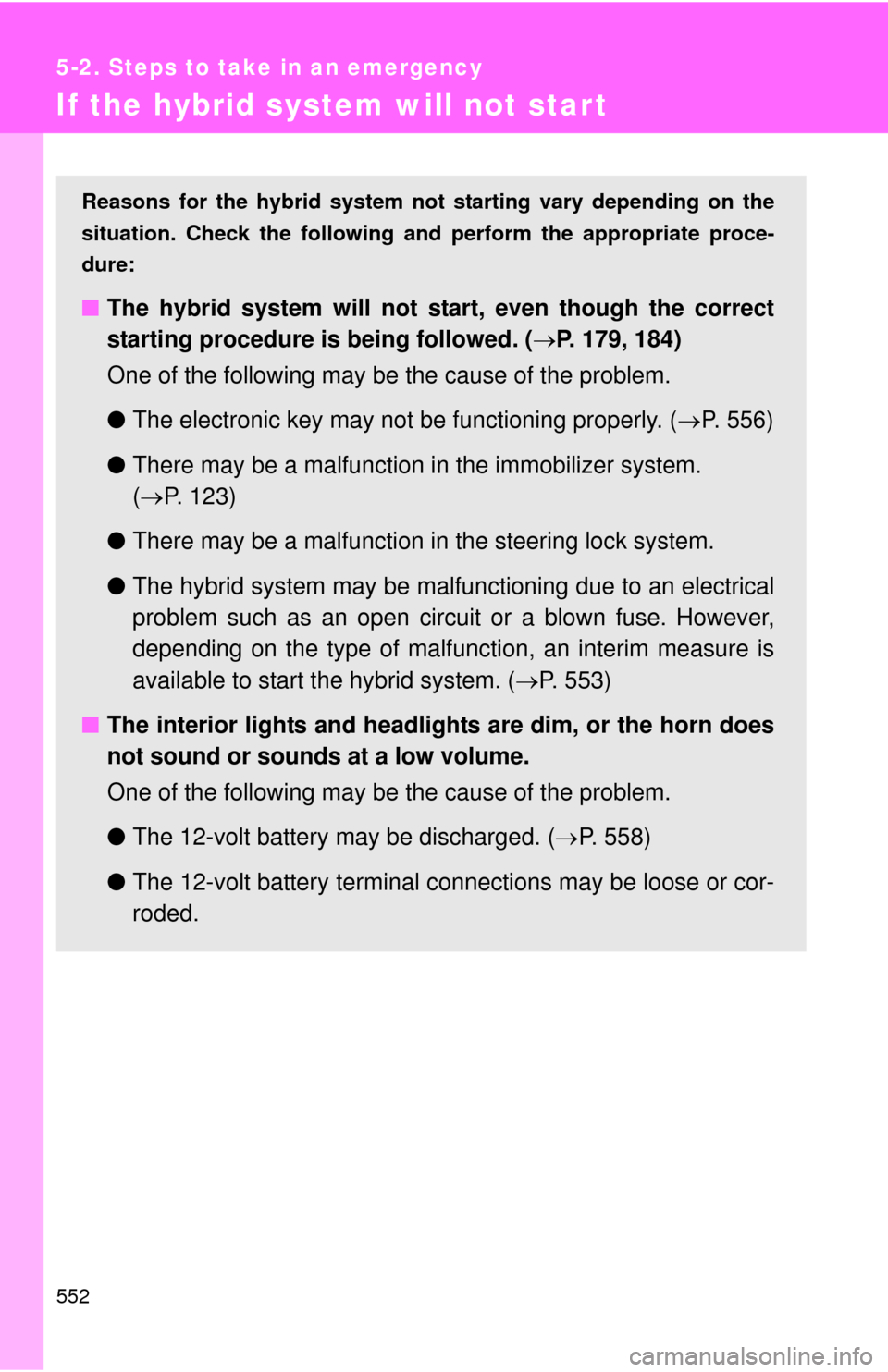
552
5-2. Steps to take in an emergency
If the hybrid system will not start
Reasons for the hybrid system not starting vary depending on the
situation. Check the following a nd perform the appropriate proce-
dure:
■ The hybrid system will not start, even though the correct
starting procedure is being followed. ( P. 179, 184)
One of the following may be the cause of the problem.
● The electronic key may not be functioning properly. ( P. 556)
● There may be a malfunction in the immobilizer system.
( P. 123)
● There may be a malfunction in the steering lock system.
● The hybrid system may be malfun ctioning due to an electrical
problem such as an open circuit or a blown fuse. However,
depending on the type of malf unction, an interim measure is
available to start the hybrid system. ( P. 553)
■ The interior lights and headlights are dim, or the horn does
not sound or sounds at a low volume.
One of the following may be the cause of the problem.
●The 12-volt battery may be discharged. ( P. 558)
● The 12-volt battery terminal c onnections may be loose or cor-
roded.
Page 553 of 636
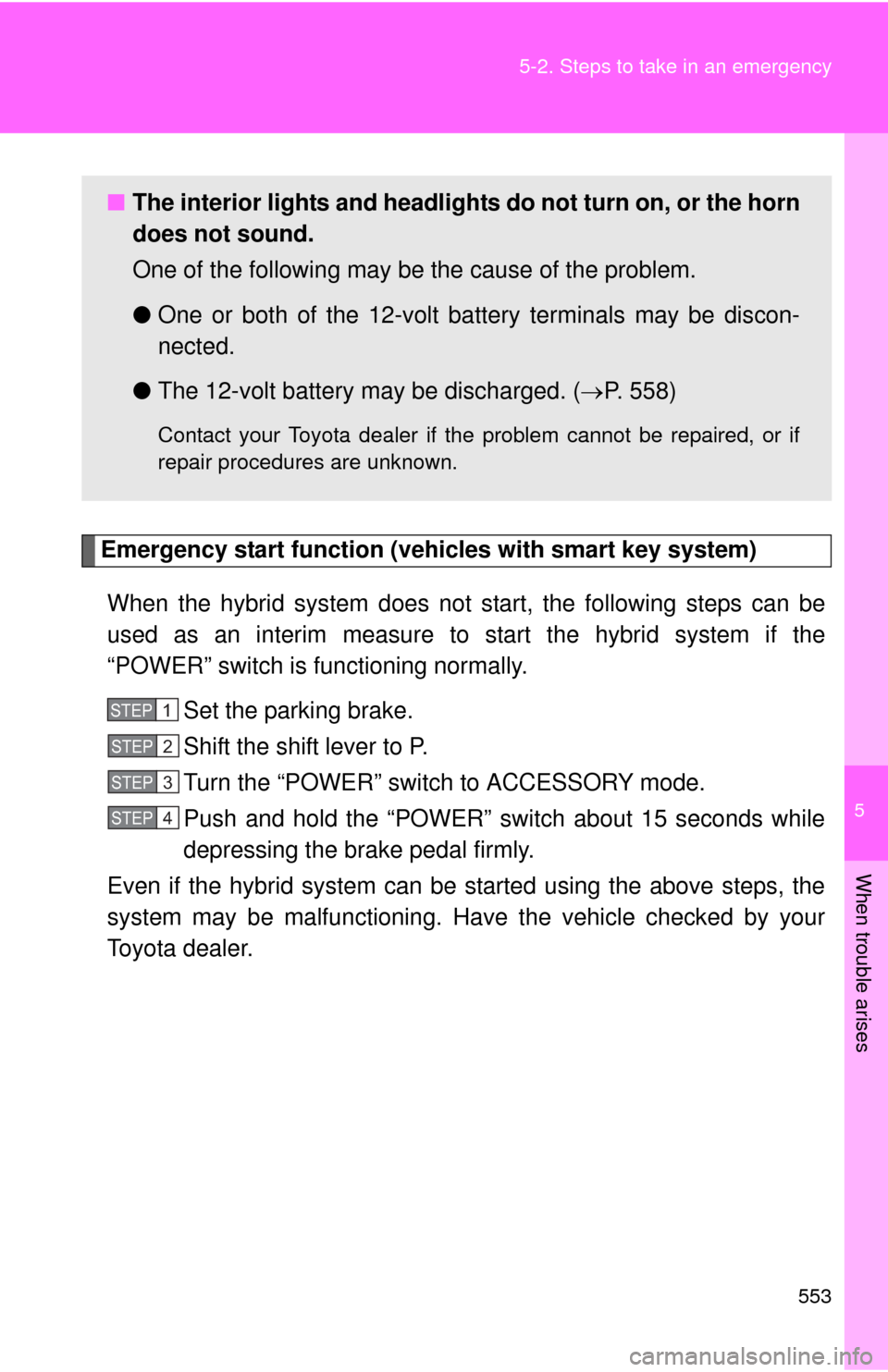
5
When trouble arises
553
5-2. Steps to take in an emergency
Emergency start function (vehicles with smart key system)
When the hybrid system does not start, the following steps can be
used as an interim measure to st art the hybrid system if the
“POWER” switch is functioning normally.
Set the parking brake.
Shift the shift lever to P.
Turn the “POWER” switch to ACCESSORY mode.
Push and hold the “POWER” switch about 15 seconds while
depressing the brake pedal firmly.
Even if the hybrid system can be started using the above steps, the
system may be malfunctioning. Ha ve the vehicle checked by your
Toyota dealer.
■ The interior lights and headlights do not turn on, or the horn
does not sound.
One of the following may be the cause of the problem.
●One or both of the 12-volt ba ttery terminals may be discon-
nected.
● The 12-volt battery may be discharged. ( P. 558)
Contact your Toyota dealer if the problem cannot be repaired, or if
repair procedures are unknown.
STEP1
STEP2
STEP3
STEP4
Page 554 of 636
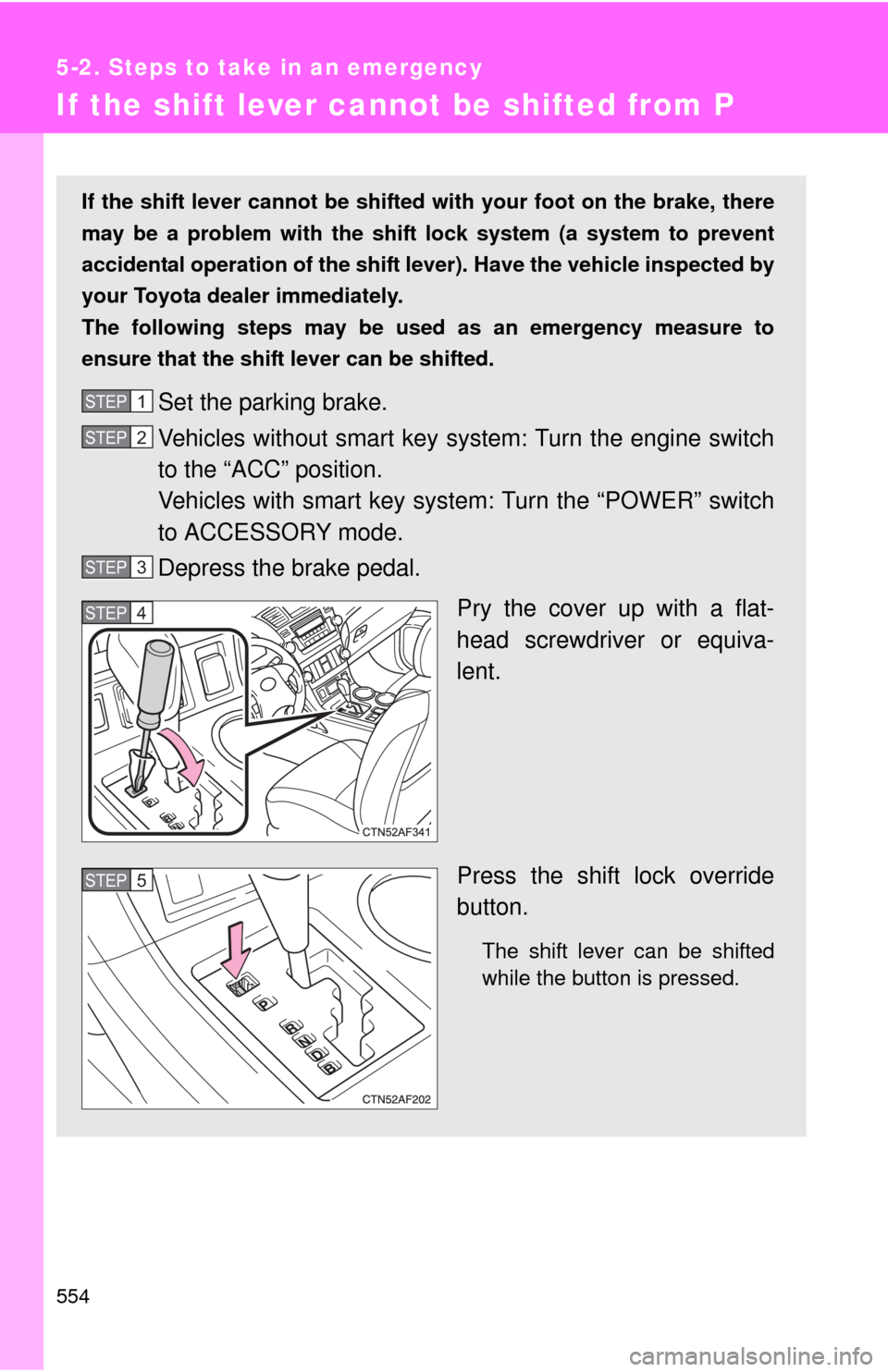
554
5-2. Steps to take in an emergency
If the shift lever cannot be shifted from P
If the shift lever cannot be shifted with your foot on the brake, there
may be a problem with the shift lock system (a system to prevent
accidental operation of the shift lever). Have the vehicle inspected by
your Toyota dealer immediately.
The following steps may be used as an emergency measure to
ensure that the shift lever can be shifted.
Set the parking brake.
Vehicles without smart key system: Turn the engine switch
to the “ACC” position.
Vehicles with smart key system: Turn the “POWER” switch
to ACCESSORY mode.
Depress the brake pedal.
Pry the cover up with a flat-
head screwdriver or equiva-
lent.
Press the shift lock override
button.
The shift lever can be shifted
while the button is pressed.
STEP1
STEP2
STEP3
STEP4
STEP5
Page 555 of 636
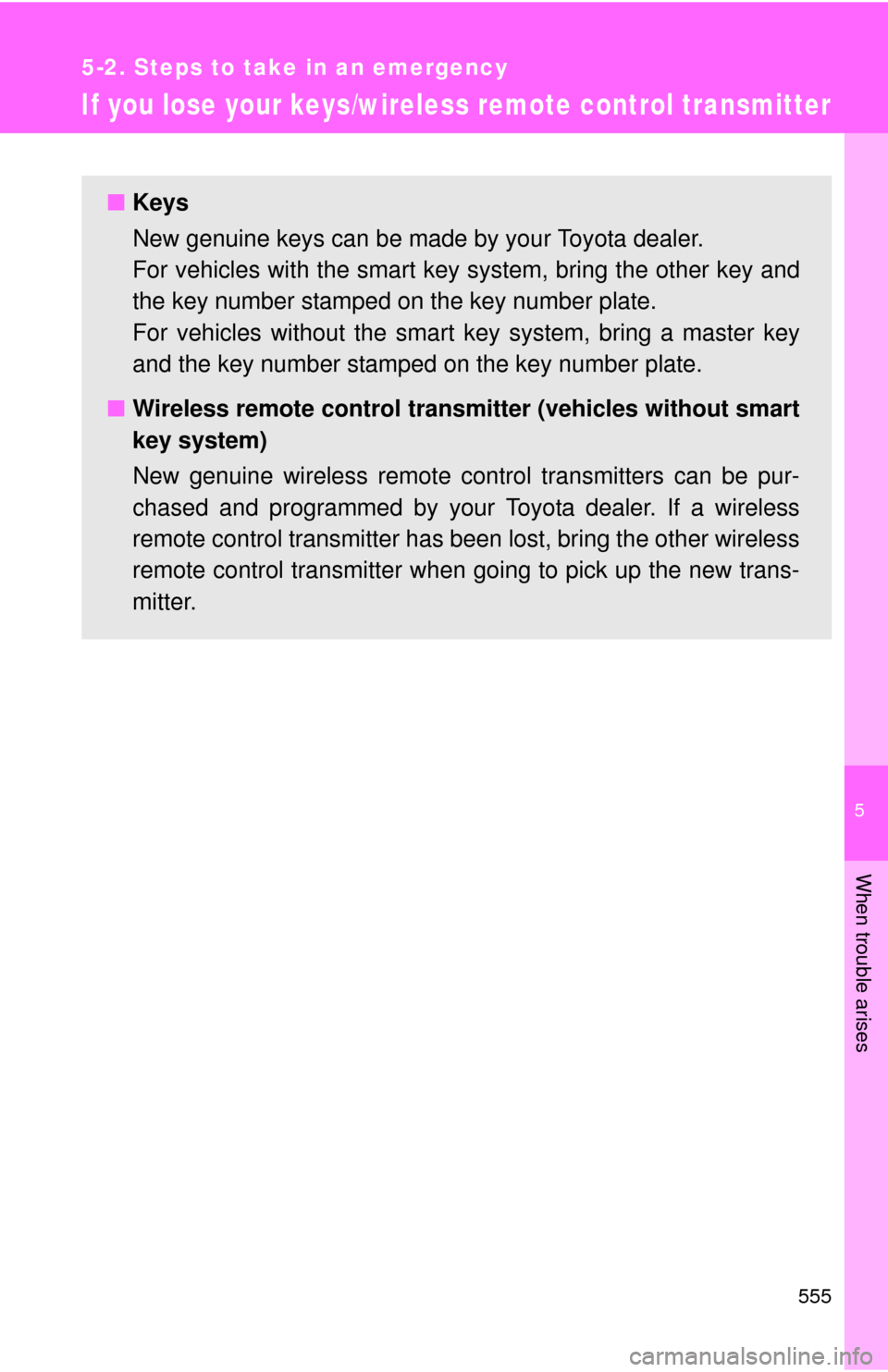
5
When trouble arises
555
5-2. Steps to take in an emergency
If you lose your keys/wireless remote control transmitter
■Keys
New genuine keys can be made by your Toyota dealer.
For vehicles with the smart key system, bring the other key and
the key number stamped on the key number plate.
For vehicles without the smart key system, bring a master key
and the key number stamped on the key number plate.
■ Wireless remote control transm itter (vehicles without smart
key system)
New genuine wireless remote control transmitters can be pur-
chased and programmed by your Toyota dealer. If a wireless
remote control transmitter has been lost, bring the other wireless
remote control transmitter when going to pick up the new trans-
mitter.
Page 556 of 636
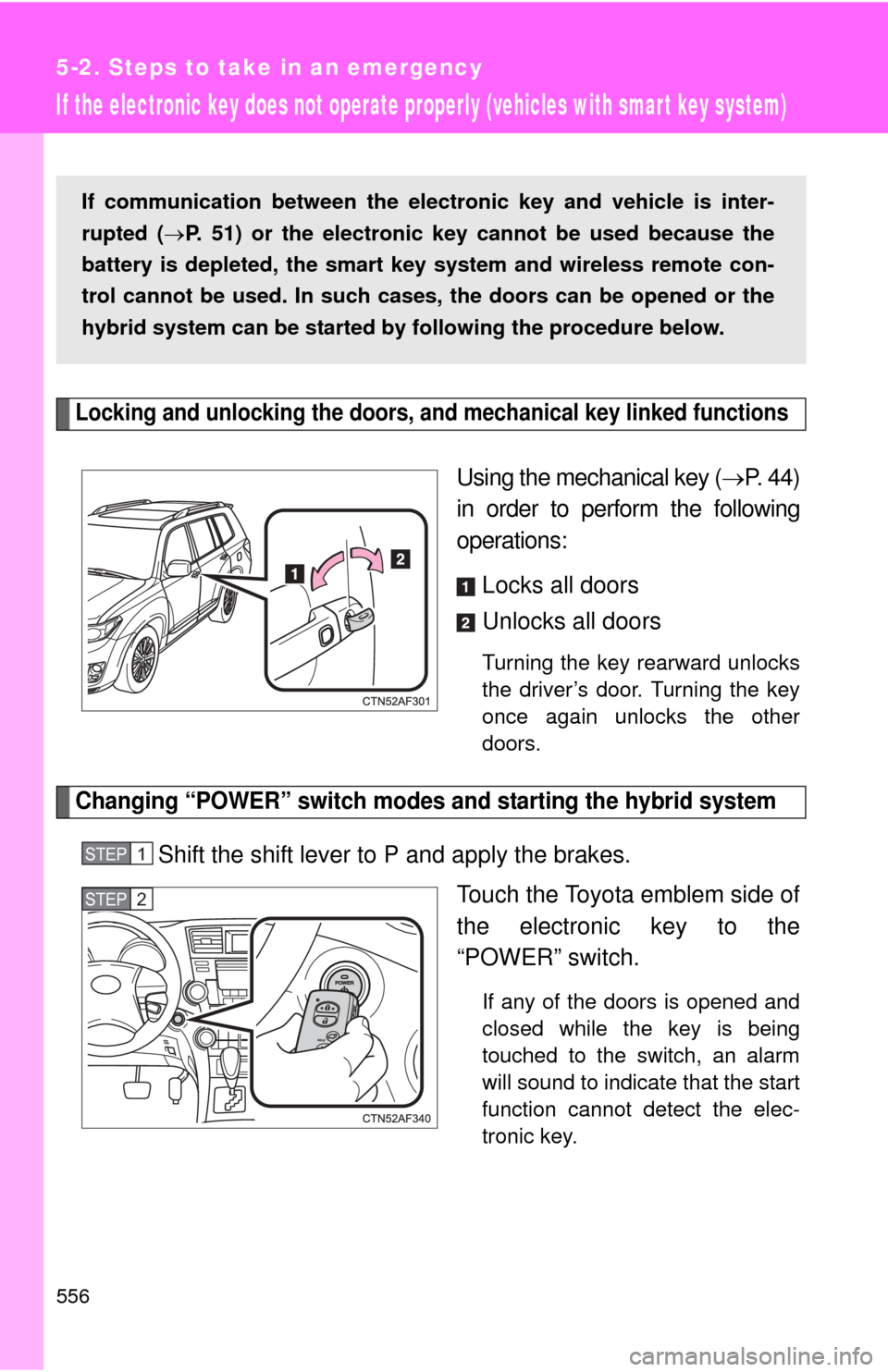
556
5-2. Steps to take in an emergency
If the electronic key does not operate properly (vehicles with smart key system)
Locking and unlocking the doors, and mechanical key linked functions
Using the mechanical key (P. 44)
in order to perform the following
operations:
Locks all doors
Unlocks all doors
Turning the key rearward unlocks
the driver’s door. Turning the key
once again unlocks the other
doors.
Changing “POWER” switch modes and starting the hybrid system
Shift the shift lever to P and apply the brakes. Touch the Toyota emblem side of
the electronic key to the
“POWER” switch.
If any of the doors is opened and
closed while the key is being
touched to the switch, an alarm
will sound to indicate that the start
function cannot detect the elec-
tronic key.
If communication between the electronic key and vehicle is inter-
rupted (P. 51) or the electronic key cannot be used because the
battery is depleted, the smart key system and wireless remote con-
trol cannot be used. In such cases, the doors can be opened or the
hybrid system can be started by following the procedure below.
STEP1
STEP2
Page 557 of 636
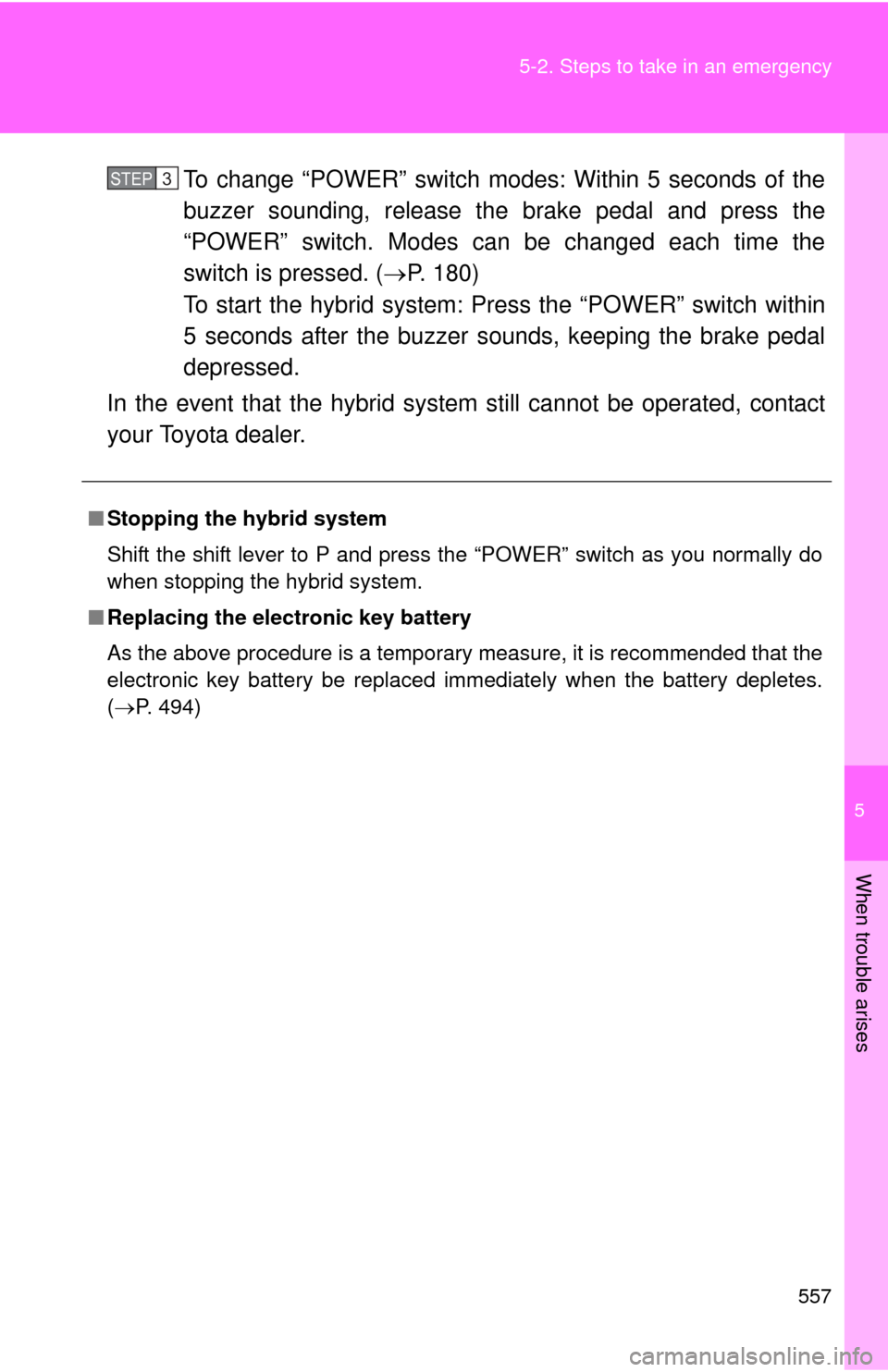
5
When trouble arises
557
5-2. Steps to take in an emergency
To change “POWER” switch modes: Within 5 seconds of the
buzzer sounding, release the
brake pedal and press the
“POWER” switch. Modes can be changed each time the
switch is pressed. ( P. 180)
To start the hybrid system: Pr ess the “POWER” switch within
5 seconds after the buzzer sounds, keeping the brake pedal
depressed.
In the event that the hybrid system still cannot be operated, contact
your Toyota dealer.
■ Stopping the hybrid system
Shift the shift lever to P and press the “POWER” switch as you normally do
when stopping the hybrid system.
■ Replacing the electronic key battery
As the above procedure is a temporary measure, it is recommended that the
electronic key battery be replaced immediately when the battery depletes.
(P. 494)
STEP3
Page 558 of 636
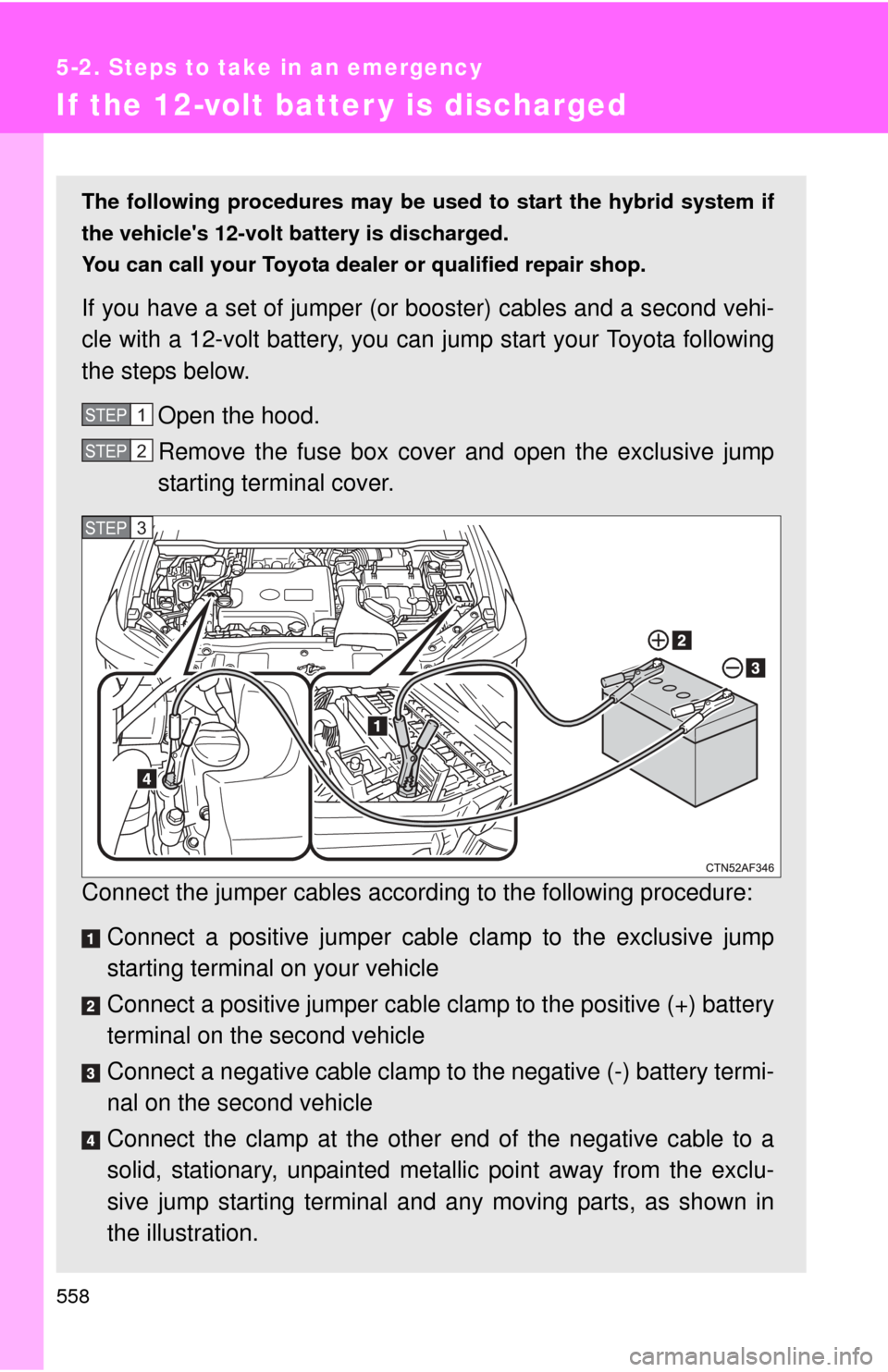
558
5-2. Steps to take in an emergency
If the 12-volt batter y is discharged
The following procedures may be used to start the hybrid system if
the vehicle's 12-volt battery is discharged.
You can call your Toyota dealer or qualified repair shop.
If you have a set of jumper (or boo ster) cables and a second vehi-
cle with a 12-volt battery, you can jump start your Toyota following
the steps below.
Open the hood.
Remove the fuse box cover and open the exclusive jump
starting terminal cover.
Connect the jumper cables accord ing to the following procedure:
Connect a positive jumper cabl e clamp to the exclusive jump
starting terminal on your vehicle
Connect a positive jumper cable clamp to the positive (+) battery
terminal on the second vehicle
Connect a negative cable clamp to the negative (-) battery termi-
nal on the second vehicle
Connect the clamp at the other end of the negative cable to a
solid, stationary, unpainted meta llic point away from the exclu-
sive jump starting terminal and any moving parts, as shown in
the illustration.
STEP1
STEP2
STEP3
Page 559 of 636
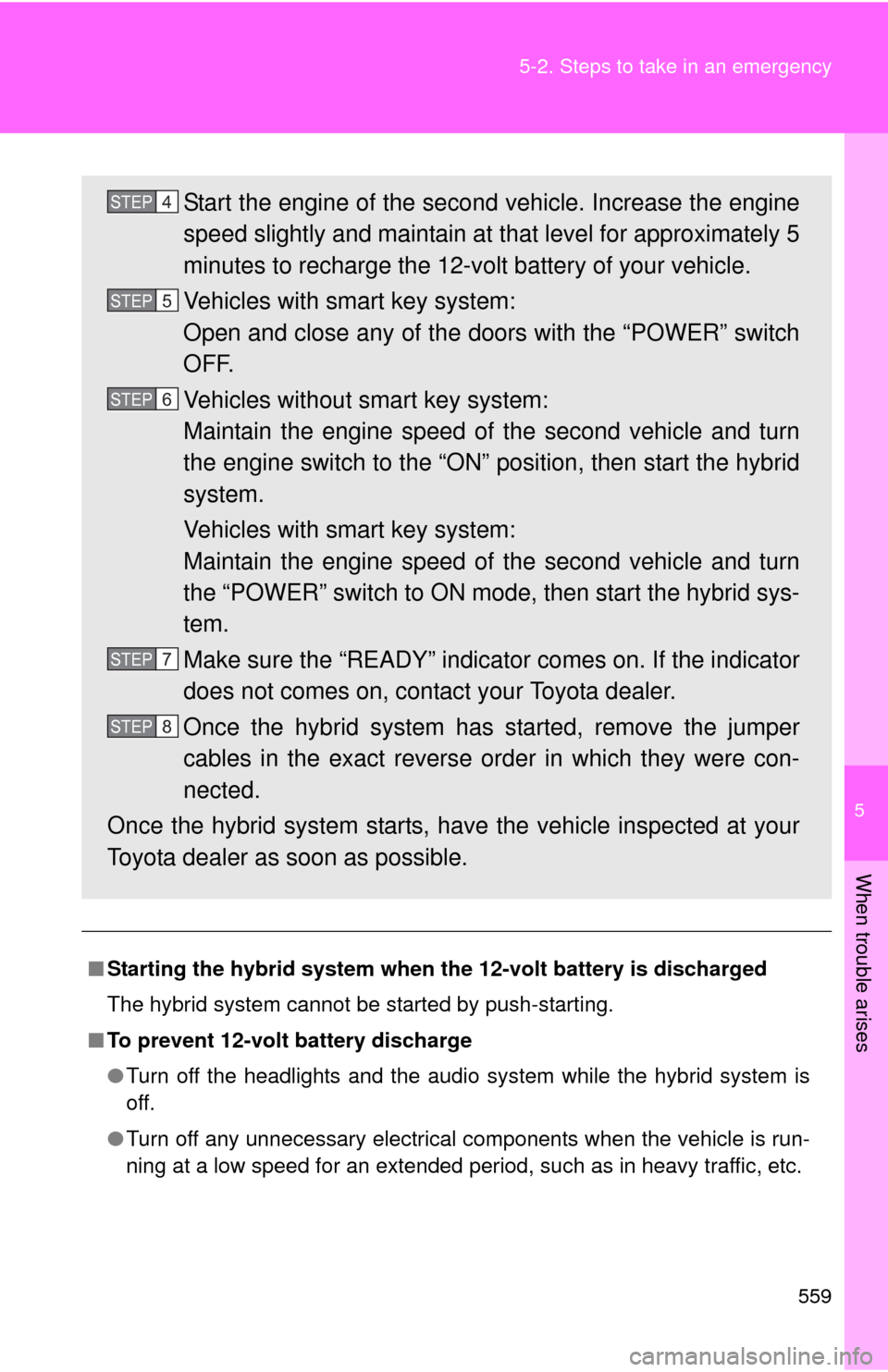
5
When trouble arises
559
5-2. Steps to take in an emergency
■
Starting the hybrid system when the 12-volt battery is discharged
The hybrid system cannot be started by push-starting.
■ To prevent 12-volt battery discharge
●Turn off the headlights and the audio system while the hybrid system is
off.
● Turn off any unnecessary electrical components when the vehicle is run-
ning at a low speed for an extended period, such as in heavy traffic, etc.
Start the engine of the second vehicle. Increase the engine
speed slightly and maintain at that level for approximately 5
minutes to recharge the 12-v olt battery of your vehicle.
Vehicles with smart key system:
Open and close any of the doors with the “POWER” switch
OFF.
Vehicles without smart key system:
Maintain the engine speed of the second vehicle and turn
the engine switch to the “ON” position, then start the hybrid
system.
Vehicles with smart key system:
Maintain the engine speed of the second vehicle and turn
the “POWER” switch to ON mode, then start the hybrid sys-
tem.
Make sure the “READY” indicator comes on. If the indicator
does not comes on, contact your Toyota dealer.
Once the hybrid system has started, remove the jumper
cables in the exact reverse order in which they were con-
nected.
Once the hybrid system starts, ha ve the vehicle inspected at your
Toyota dealer as soon as possible.STEP4
STEP5
STEP6
STEP7
STEP8
Page 560 of 636
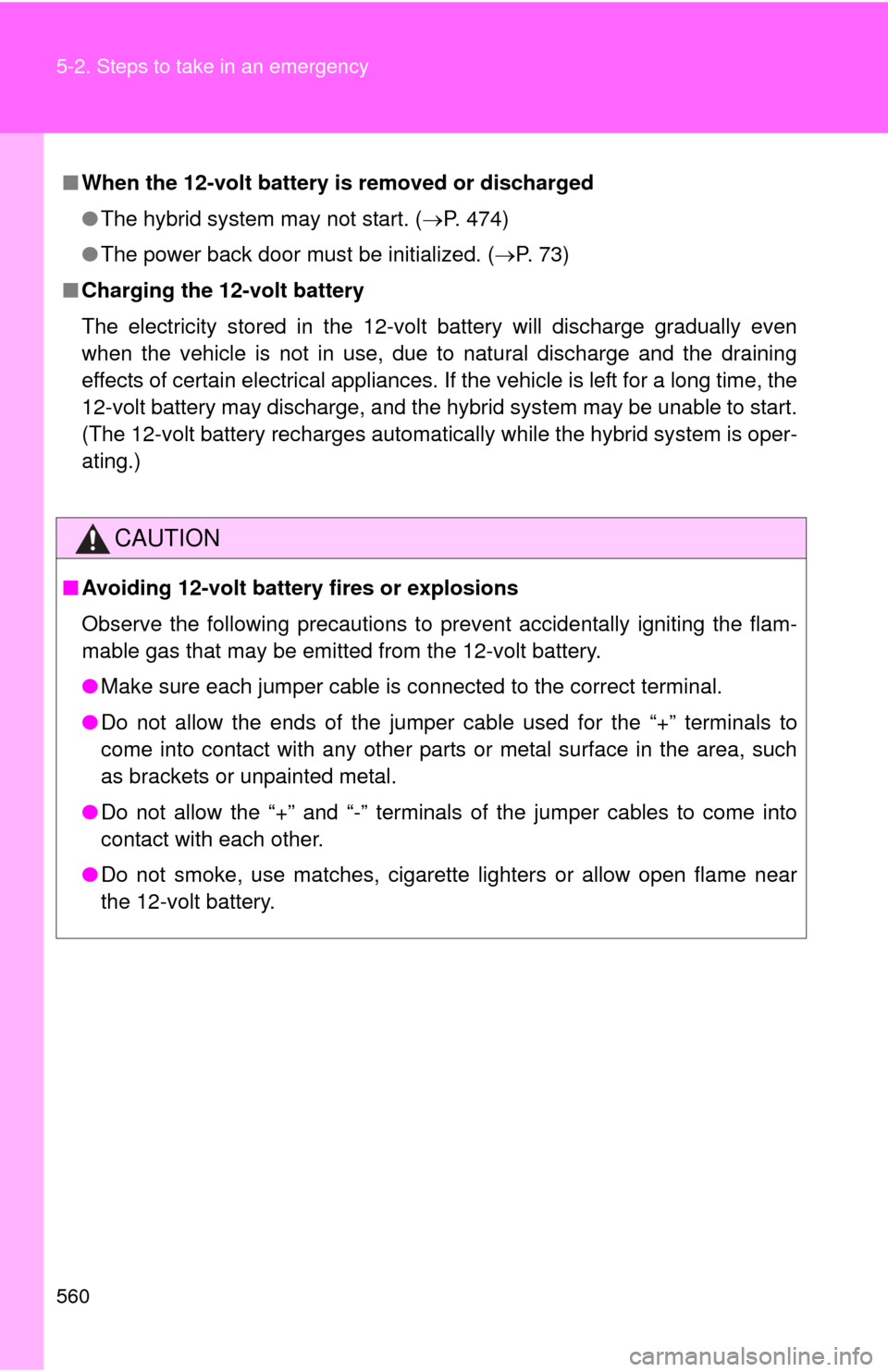
560 5-2. Steps to take in an emergency
■When the 12-volt battery is removed or discharged
●The hybrid system may not start. ( P. 474)
● The power back door must be initialized. ( P. 73)
■ Charging the 12-volt battery
The electricity stored in the 12-volt battery will discharge gradually even
when the vehicle is not in use, due to natural discharge and the draining
effects of certain electrical appliances. If the vehicle is left for a long time, the
12-volt battery may discharge, and the hybrid system may be unable to start.
(The 12-volt battery recharges automatically while the hybrid system is oper-
ating.)
CAUTION
■ Avoiding 12-volt battery fires or explosions
Observe the following precautions to prevent accidentally igniting the flam-
mable gas that may be emitted from the 12-volt battery.
●Make sure each jumper cable is connected to the correct terminal.
● Do not allow the ends of the jumper cable used for the “+” terminals to
come into contact with any other parts or metal surface in the area, such
as brackets or unpainted metal.
● Do not allow the “+” and “-” terminals of the jumper cables to come into
contact with each other.
● Do not smoke, use matches, cigarette lighters or allow open flame near
the 12-volt battery.